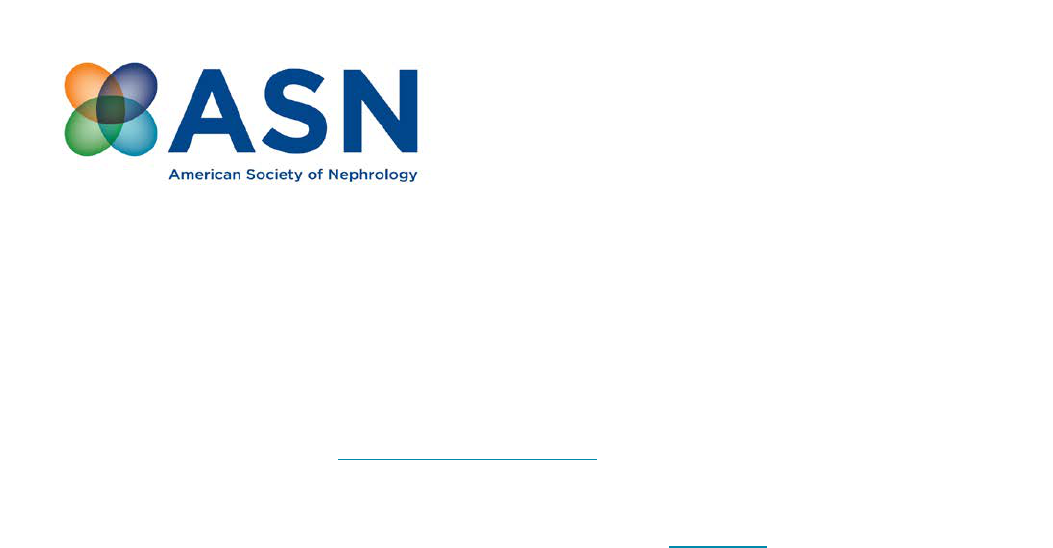
These guidelines are being provided to you as a planner, presenter, or author in a
continuing education (CE) activity provided by ASN. We value your expertise and
contribution to high-quality medical education that is scientifically rigorous and evidence
based.
The purpose of the ASN CE program is to close the knowledge and/or performance-in-practice
gaps of nephrology clinicians, scientists, and other professionals regarding quality, person-
centered health care (ASN CE Mission Statement
).
1. ASN Conflict of Interest and Disclosure Policy: All people in a position to control
the content of educational activities must adhere to this policy
, including but not limited to:
providing full disclosure of any potential conflicts, and disclosing any/all relationships
(financial and other interests) within the past 24 months in the spirit of total transparency.
2. Balanced View: All planners, presenters, and authors of educational activities must promote
improvements or quality in health care and not a specific proprietary business interest or a
commercial interest. All must give a balanced view of therapeutic options and use generic
names whenever possible.
3. Commercial Bias: All planners, presenters, and authors of educational activities must not
advertise or promote products during educational activities.
4. Unlabeled Use: If an unlabeled use of a commercial product or an investigational use not
yet approved for any purpose is discussed, all planners, presenters, and authors of
educational activities must disclose to learners that the product is not labeled for the use
under discussion or that the product is still investigational. Should an unplanned discussion
of unlabeled or investigational uses of a product occur (e.g., question-and-answer portion),
all planners, presenters, and authors must inform learners that the use under
question/discussion is unlabeled or investigational prior to answering the question or
responding to the discussion point.
5. Copyright: Presenters/authors should not infringe or otherwise violate any proprietary or
personal rights of others (including but not limited to copyrights or privacy rights in the
United States and all foreign countries). Presenters/authors should obtain all necessary
permissions and licenses from the copyright owner(s) for all third-party content (including
but not limited to graphs, charts, algorithms, graphics, photographs, text, and data), in whole
or in part, in the presentation and the related materials; and the presentation and the related
materials are factually accurate and contain no libelous or otherwise unlawful statements.
6. Political Comments: Educational content should focus on closing the knowledge and/or
performance-in-practice gaps of learners regarding quality, person-centered health care and
policy initiatives relating to kidney diseases. Educational content should not include
political/party comments, views, and/or satirical references (e.g., political cartoons).
Guidelines for Educational
Planners, Presenters, and Authors
Updated: January 2022
7. For Planners: In selecting presenters/authors, planners should consider if there is a leader in
this content field that can be chosen for their expertise to showcase nontraditional minority
participation. Examples: race, ethnicity, sex, gender identity, broad age range, people with
disabilities, location/region, practice type, degree (MD, DO, PhD, APRN, PharmD, etc.).
8. For Presenters/Authors:
• Sociodemographic Bias – Toward preparing learners to consider the broad scope of
risk factors for kidney and related diseases, presenters and authors must carefully
consider the need for sociodemographic identifiers (e.g., race, ethnicity, country of
origin, language spoken, veteran status) in clinical vignettes. Avoid using
sociodemographic identifiers when they might lead learners to link these identifiers
to certain conditions and not others or are not relevant to the clinical presentation.
• Contextual Bias – Planners and authors should consider where could contextual bias
be present, a thought-provoking item for learners or an area that could spur
discussion. Examples: limited grocery options in patients with high phosphorus,
inability to travel for transplantation due to responsibilities, work constraints limiting
water intake, veteran experiences leading to PTSD and hypertension, side effects of
phosphate binders limiting compliance.
• Financial Bias – Planners and authors should consider economic factors that may
influence a patient’s ability to participate in care in the assigned content
area. Examples: persons who hold multiple jobs that limit their ability to participate in
care, limitation of telehealth visits when there is no smart phone or reliable internet,
home dialysis options for those with housing insecurity, challenges following dietary
recommendations in situations of food insecurity, insurance limitations.
• Other Bias – Planners and authors should consider other types of bias in the
assigned content area. What mechanisms can be shared with learners to recognize
and lessen bias for learners? Example: When discussing studies that were performed
in a limited population (race, ethnicity, sex, location/region, geographic disparities,
etc.), it is important to explicitly acknowledge it and address potential limitations of
generalizing study results.
Guidelines for ASN Educational
Planners, Presenters, and Authors
Page 2
